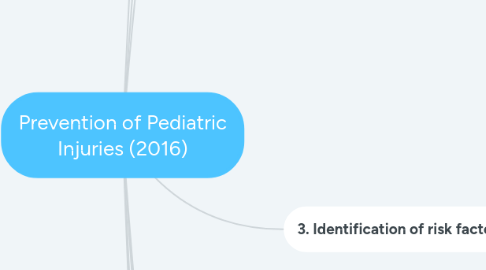
1. 1. Injury surveillance
1.1. Sports
1.1.1. basketball
1.1.1.1. metatarsal stress fractures
1.1.2. track athlete
1.1.2.1. soccer players
1.1.2.1.1. tibial shaft fracture
1.1.2.1.2. pubic bone
2. 7. Delayed specialization
2.1. young athletes who participate in a variety of sports to have
2.1.1. fewer injuries
2.1.2. play longer
2.1.3. maintaining a higher level of physical activity
2.1.3.1. than those who specialize before puberty
3. 6. Training and conditioning
3.1. 10% rule
3.1.1. no more than a 10% increase in
3.1.1.1. the amount of training time
3.1.1.2. distance
3.1.1.3. repetitions
3.1.1.4. load
3.1.1.4.1. each week
3.1.2. examples
3.1.2.1. strength training program
3.1.2.1.1. only either reps or weight by 10% each week
3.1.2.1.2. change only one of factors
3.2. Preventive training program
3.2.1. the program was more effective in reducing injuries
3.2.1.1. among those adolescents who reported sustaining an injury in the previous year
3.2.1.2. thus highlighting the need to identify injury history through a thorough PPE
3.2.2. components
3.2.2.1. strengthening
3.2.2.2. neuromuscular control
3.2.2.3. flexibility
3.2.2.4. balance
3.2.2.5. technique training
4. 5. Sports alterations
4.1. Little League Baseball
4.1.1. Pitch-count regulation
4.1.1.1. with 4 day rest
4.1.1.1.1. 13-14
4.1.1.1.2. 17-18
4.1.2. Tracking sheet
4.1.3. Pitching eligibility forms
4.1.4. Pitching limit
4.1.4.1. 9-14
4.1.4.1.1. <75 / game
4.1.4.1.2. < 600 pitches per season
4.2. The US Cycling Federation
4.2.1. gear-ratio limit
4.3. Running organization in Australia
4.3.1. 5km
4.3.1.1. 12 yrs
4.3.2. 10 km
4.3.2.1. 14 yrs
4.3.3. 21 km
4.3.3.1. 15-16
4.3.4. 42 km
4.3.4.1. > 18 years
4.4. USA swimming
5. 4. Proper supervision and education
6. 3. Identification of risk factors
6.1. Intrinsic risk factors
6.1.1. Previous hx
6.1.2. malalignment
6.1.3. menstrual cycle
6.1.4. psychological issues
6.1.5. muscle imbalances
6.1.6. inflexibility
6.1.7. muscle weakness
6.1.8. instability
6.1.9. level of play
6.1.10. age
6.1.11. height
6.1.12. sex
6.1.13. Tanner stage
6.1.14. laxity
6.2. Extrinsic risk factors
6.2.1. Training and recovery
6.2.2. Equipment
6.2.3. Poor technique
6.2.4. Psychological issues
6.2.4.1. これはextrinsic なんやね
6.2.5. Environment
6.2.6. Sport-aquired deficiencies
6.2.7. conditioning
6.3. Risk factors for elbow and shoulder pain
6.3.1. arm fatigue
6.3.1.1. 6 time more likely to have
6.3.1.1.1. elbow pain
6.3.1.2. 4 time more likely to have
6.3.1.2.1. shoulder pain
6.3.2. self-perceived performance
6.3.3. pain
6.3.3.1. don't ignore
6.3.4. Pitch type
6.3.4.1. greater fastball speed
6.3.4.1.1. higher risk
6.3.4.1.2. > 85 mph
6.3.4.1.3. biomechanics
6.3.4.2. use of breaking pitch
6.3.4.2.1. use of slider
6.3.4.2.2. use curve
6.3.4.2.3. not necessarily risky
6.3.4.3. changeups
6.3.4.3.1. the safest
6.3.5. Pitch count
6.3.5.1. high pitch count
6.3.5.2. participating in more than 8 months of competitive pitching
6.3.5.3. > 80 pitches / game
6.3.6. Pitching mechanics
6.3.6.1. not a risk factor
6.4. MTSS
6.4.1. Risk factor
6.4.1.1. Navicular drop >6.6 mm
6.4.1.1.1. than those who were asymptomatic
6.4.1.2. Previous injury
6.4.1.2.1. 2 times more likely to report
6.4.1.3. Use orthotics
6.4.1.3.1. 3 times more likely to report
6.4.1.4. Age
6.4.1.4.1. 27% increase each year
6.4.1.5. > 16 hrs vigorous activity
6.4.1.6. high impact physical activity
6.4.1.7. family history of
6.4.1.7.1. osteoporosis
6.4.1.7.2. osteopenia
6.4.1.8. hypermobile
6.4.1.8.1. controversial
6.4.2. Not risk factor
6.4.2.1. resting calcaneal position
6.4.2.2. tibiofemoral varum
6.4.2.3. gastrocnemius length
6.4.2.3.1. tightness
7. 2. PPE
7.1. history
7.1.1. stress fractures
7.1.2. chronic
7.1.3. recurring musculoskeletal injuries
7.1.3.1. may be associated with
7.1.3.1.1. nutritional insufficiencies
7.1.4. if yes
7.1.4.1. more thorough joint-specific exam should be conducted
7.2. Evaluation of maturity
7.2.1. Tanner stage
7.3. PPE is mandated for high school athletes
7.3.1. but not a requirement for
7.3.1.1. club based
7.3.1.2. youth sports
8. Background
8.1. Major types
8.1.1. Epiphyseal plate
8.1.1.1. compression
8.1.2. Apophysis
8.1.2.1. repeated tension or traction forces
8.2. In throwers
8.2.1. Capitellar osteochondritis dissecans
8.2.1.1. repetitive microtrauma
8.2.1.2. separation of
8.2.1.2.1. articular cartilage
8.2.1.2.2. subchondral bone
8.2.1.3. Sequelae
8.2.1.3.1. degenerative changes
8.3. Factors of injury risk
8.3.1. growth rates
8.4. Prevention of pediatric overuse injuries
8.4.1. 7 components
8.4.1.1. 1. Improved injury surveillance
8.4.1.2. 2. Identification of risk factors for injury
8.4.1.3. 3. Thorough PPEs
8.4.1.4. 4. Proper supervision and education
8.4.1.5. 5. Sport alterations
8.4.1.6. 6. Improved training and conditioning programs
8.4.1.7. 7. Delayed specialization
8.5. Advocated by
8.5.1. ACSM
8.5.1.1. american college of sports medicine
8.5.2. WHO
8.5.2.1. world health organization
8.5.3. IFEM
8.5.3.1. international federation of sports medicine
8.5.4. AAP
8.5.4.1. American Academy of Pediatric
8.5.5. IOC
8.5.5.1. International Olympic Committee

